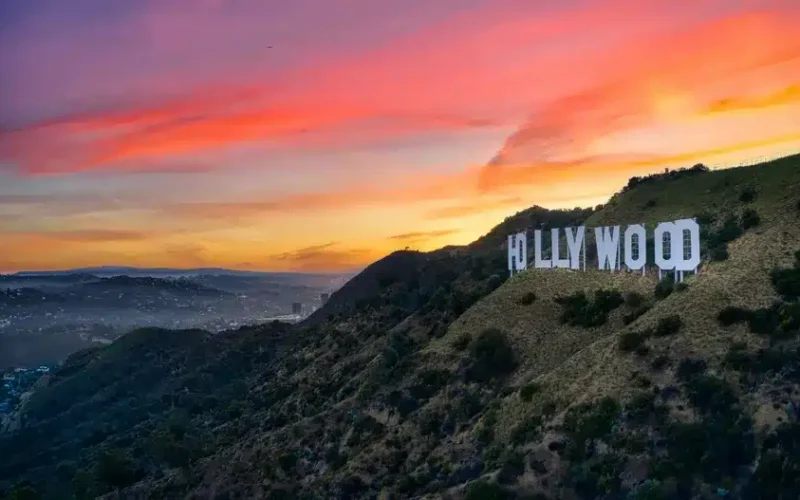In reviewing the history of Hollywood, it’s no secret than Hollywood holds star power – and we don’t just mean celebrity power, we also mean astronomy as well. Besides being known for its celebrities, filming locations, and beautiful views, Hollywood has a rich history and is home to many landmarks, like the Griffith Observatory and Hollywood Walk of Fame. We’ll take a look at the history of Hollywood, the influence in the film industry, snd we’ll check out some Tinseltown trivia.
History of Hollywood: How it All Started
In the late 1800s, well-to-do landowners Harvey Wilcox and his wife Daeida bought a large amount of acreage northwest of LA. Daeida (or Ida) named it Hollywood, for her love of the landscape and in particular, holly bushes. Around that time, most of entertainment was put on vaudeville-style, meaning that there were only traveling roadshows, nothing like the movies we have and treasure today.
In the late 1870s a man by the name of Edward (or Eadweard) Muybridge made use of a “motion toy” so he could film horses galloping. It worked by capturing the motion in quick sequences. Soon, George Eastman (of Eastman Kodak) and William Walker helped hone motion photography, and ultimately the Lumière brothers invented the cinématographe, which was a hand cranked machine. This marked the beginning to the history of Hollywood.
History of Hollywood: The Birth of Film
So there we have it – that was how motion pictures had their start; this made it more convenient for people to watch what we now call “movies” on a flat surface. Audiences didn’t have to travel so far, or follow a live act to see a story play out. And Hollywood made use of it!
In the early 1900s, once the concept of motion filming was known, there was a plethora of films made. They were grainy, jerky, and silent, black-and-white films. One of the most recognized actors from this time was Charlie Chaplin, and an innovative director was John Ford. Known for movies like The Quiet Man and The Grapes of Wrath, Ford and other Hollywood producers like Cecil B. DeMille and D.W. Griffith would go on to produce many groundbreaking motion pictures.
Hollywoodland Sign
Let’s cut to another scene of this tale and examine some landmarks. The Hollywood sign, which is by Griffith Park (near the observatory) has an interesting history. It was originally erected in 1923 to mark a new real estate development called Hollywoodland. It was only supposed to be temporary. The sign stayed and in 1949 the “land” part of the sign was removed so it would reflect the region, and not just a neighborhood.
The sign has been refurbished several times and was completely redone in 1978. Access to the sign is highly restricted, as governing agencies are concerned about vandals, wildfires, the surrounding environment, and sign climbers. Fun fact: metal singer Alice Cooper sponsored one of the Os in the renovated sign. This is a big symbol and play a massive role in the History of Hollywood.
Film Production Studios
Sun snd fun won out – and with the mild weather and beautiful scenery (making for a perfect background), Hollywood beckoned producers. Some of the oldest studios were founded: Warner Brothers, MGM, and soon Paramount. Motion pictures and Hollywood were about to have their heyday. The late 1930s and 1940s are often considered the “Golden Age of Hollywood,” since much money was spent on sets, filming, and casting celebrities for roles.
In the latter part of the 1950s and 1960s, Hollywood saw a decline in movie attendance. The small screen (television) had been invented in the 1940s – and everyone had one. This would count for the changes to production in the moviemaking industry.
The 1980s and 1990s saw a resurgence with bigger blockbuster hits. Movies with epic special effects came out and gave us thrillers like the Star Wars franchise, Jaws, and Titanic. This would set a precedent for future movies to eclipse. Their contribution to the entire history of Hollywood has been immense.
Landmarks in Hollywood
What to see first? There are so many you could see, like the Hollywood Bowl, drive up the famed Mulholland Drive, or see the Cinerama Theatre. Because of the heavy amount of tourism, business meetings, and production arrangements made in Hollywood, there are many hotels, with a large percentage of them historic, like the Château Marmont.
For those who want to appreciate nature, there are lots of hiking trails and parks. The views from Hollywood Hills are stunning – like no other in the United States. The 2016 Award-winning movie La La Land makes use of these landmarks in Hollywood and around Los Angeles. Another thing that the movie does is that it pays tribute to Hollywood’s golden years, enhancing the history of Hollywood.
Strolling on Sunset Boulevard
So now that we’ve touched upon the history of Hollywood, how does Sunset Boulevard figure so prominently in Hollywood’s history? The 22 mile road runs east and west and cuts through Hollywood. It was named for the beautiful sunset when one travels west towards the Pacific Ocean.
Sunset Boulevard has long been a hub of theaters, nightclubs, hotels, and trendy restaurants. There is shopping, sidewalk cafés, and plenty of opportunities for photo taking on Sunset. And yes, movies and shoes are still filmed today along this famous boulevard.
Summing it All Up
Hollywood and Sunset Boulevard have rich histories. The iconic landmarks, striking views, and infamous filming sites play a huge role in its long history.
Hollywood has seen much change brought on by shifts in the film industry. Production has waxed and waned over the decades, with Hollywood film creation falling on some difficult times. Somehow it bounces back. History of Hollywood, celebrities, and film production are all inextricably linked and still will be for a long time to come.








